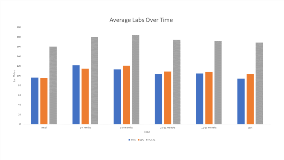Pediatric Lipid Panels in Children Treated with Prolonged Ketogenic and Modified Atkins Diet Therapy
Abstract number :
3.355
Submission category :
10. Dietary Therapies (Ketogenic, Atkins, etc.)
Year :
2018
Submission ID :
489897
Source :
www.aesnet.org
Presentation date :
12/3/2018 1:55:12 PM
Published date :
Nov 5, 2018, 18:00 PM
Authors :
Chelsey Stillman, Childrens Hospital Colorado; Stephanie Criteser, Childrens Hospital Colorado; and Sarah Graber, Childrens Hospital Colorado
Rationale: Almost 2 million people in the United States have epilepsy. While 70 - 80% of individuals are successfully treated with an antiepileptic drugs (AED), 20 to 30% of patients either have intractable seizures or significant adverse side effects which lead clinicians to pursue nonmedication options such as Ketogenic Diet (KD). It is well documented that the ketogenic diet (KD) has the potential to increase lipid parameters in children especially in the first 6 months (Zamani et al). Many studies exist examining the lipid panels in children within the first year of treatment, though there are limited data investigating lipid panels in children on KD beyond 12 months. Additionally there is (McDonald et al) data on lipid parameters in modified atkins diet (MAD) in adults but there appears to be minimal long term data regarding lipid parameters in children in MAD and KD . This QI project aimed to address the long-term lipid parameters in children on both KD and MAD specifically looking at low density lipoprotein (LDL), triglycerides (TG) and total cholesterol (TC) Methods: We assessed our population of patients (total 125) and selected patients who initiated KD or MAD in the last 8 years and 10 years ago, or emergently in the ICU were excluded due to lack of initial data. Children on the diet 12 months. We recorded values until most recent recorded which varied in duration of diet depending on the patient. Our typical frequency of fasting lab values is every 6 months based on the only published guideline to date (Kossoff et al, 2008) Results: LDL, TG and TC were found to peak at 11.52 months, 12.9 months and 11.48 months respectively. The peak value for LDL, TG and TC respectively were 129 (mg/dL) , 138 (mg/dL) and 193 (mg/dL). After 12 months, parameters returned to near pre-diet levels. Initial TG mean level was 96(mg/dL) and the 12-18-month mean was 108 (mg/dL). Initial LDL mean level was 95(mg/dL) and the 12-18 month mean level was 108(mg/dL). Initial TC mean level was 159(mg/dL) and the 12-18 mean level was 171(mg/dL). The last recorded value for TG, LDL and TC showed further decline at 94(mg/dL), 103(mg/dL) and 160(mg/dL) respectively. P values were not completed due to low N per statistician Conclusions: To reduce health care costs, lipids could be completed less frequently, perhaps starting after 12 months on diet as there is clear elevation within the first year with return to pre-diet levels after 12 months. There has been mention in adults that the normal lipid values did not account for sub LDL groups which is an area in need of further investigation for children. We intend to use results of this QI project to educate families regarding laboratory expectations who may appear anxious about increased lipid lab values within the first year to assure them that patients near pre-keto lipid parameters after 12 months of therapy Funding: None
